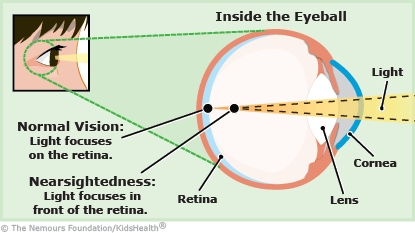Nearsightedness (Myopia): How to Care for Your Child
Kids with nearsightedness (myopia) can see things better up close than far away.
In normal vision, light that reflects off an object enters the eye through the cornea and lens and focuses on the retina, at the back of the eye. The brain "sees" a clear image. In myopia, the light focuses in front of the retina, instead of directly on it. The brain "sees" a blurry image.
Glasses or contact lenses can help your child see clearly. Myopia may get worse during the teen years as the body grows a lot, so your child needs regular eye exams to check if they need different glasses or contact lenses. Myopia tends to change less in adulthood. Your health care provider can talk to you about things that may help slow the worsening of myopia.


Follow your health care provider's advice for:
-
whether eyeglasses or contact lenses (or both) are best for your child
-
when your child needs to wear their glasses or contact lenses
-
how to care for your child's glasses or contact lenses
-
what material is best if your child gets eyeglasses. Plastic frames and shatterproof glasses are safest.
-
things to do that may slow the worsening of myopia, such as having your child:
-
spend plenty of time outdoors so they can look at things that are far away
-
limit time spent on close-up activities, such as screens and reading. A general guideline is the 20-20-20 rule (take a 20-second break to look at something 20 feet away every 20 minutes).
-
wear special contact lenses
-
use prescription eye drops
-
when to follow up
Other tips:
-
If your child gets eyeglasses, help make it fun by letting them pick a style and color they like.
-
Make sure your child understands when they should wear their eyeglasses or contact lenses.
-
If your child gets contact lenses, help them follow all instructions for wearing and caring for them to prevent eye infections and other problems.

Your child:
-
has headaches or eye pain
-
has blurry vision when wearing glasses or contacts
-
is seeing flashing lights or floating spots
-
has any loss of vision
Call your health care provider if your child wears contacts and:

What are the signs of myopia? Kids with myopia have blurry vision when looking at things that are far away. They may also squint and blink a lot and hold books and toys closer to their face than usual.
Can eye surgery help with myopia? Eye surgery can help with myopia but only after a person's eyes are done growing and their myopia hasn't gotten worse in the past year. For most people, this is when they're 18–21 years old. The surgery, called laser refractive surgery, is done by ophthalmologists (doctors who treat eye problems) using lasers to change the shape of the cornea to correct the myopia.